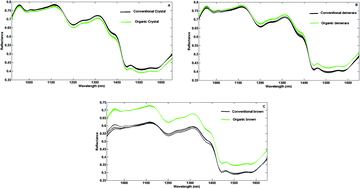Authentication of organic sugars by NIR spectroscopy and partial least squares with discriminant analysis†
Abstract
The present study evaluated the potential of near-infrared (NIR) spectroscopy coupled with partial least squares with discriminant analysis (PLS-DA) for the authentication of organic sugars. Portable NIR equipment was employed in the range from 900 to 1650 nm. Three PLS-DA models were built: the first one for discriminating organic sugar from conventional crystal sugar, a second model for discriminating organic sugar from conventional demerara sugar, and the third one for discrimination of organic sugar from conventional brown sugar. The sensitivity and specificity for the PLS-DA models were equal to 1 in all cases, indicating high ability in the authentication of sugars (crystal, demerara, and brown) as organic and conventional ones. The ability of NIR spectroscopy for organic sugar authentication can be assigned to a shift in the absorption bands in the regions of the first, second and third overtones, probably due to the differences in the amount of compounds that present these bonds in the organic and conventional sugars. Thus, it can be suggested that the organic sugar samples had differences in chemical composition which are detected by NIR spectroscopy coupled to the chemometric method PLS-DA, allowing the differentiation of organic samples from conventional ones.



 Please wait while we load your content...
Please wait while we load your content...